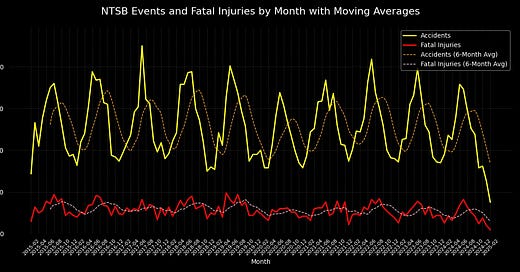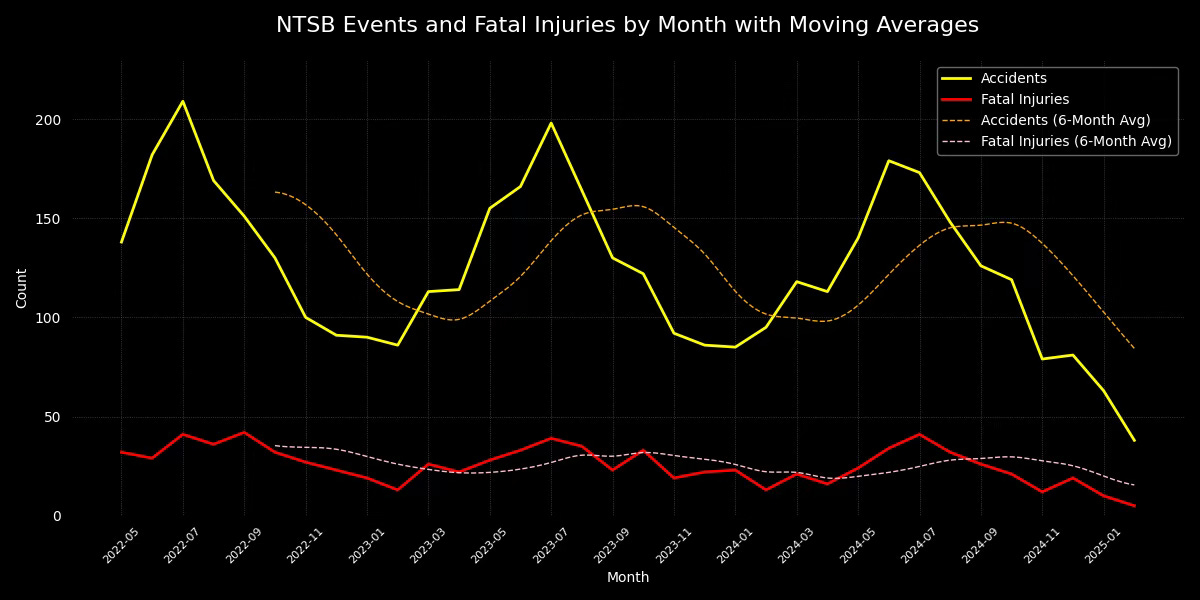Hello Intrepid SkyRider,
Welcome to the second edition of SkyWatch, a weekly flight operations review from AVIAR LABS. Each week, we’ll use the SkyGlass 3D flight tracking platform to highlight key flight activities for selected aircraft, types and watchlist groups.
This week, I'm departing from the usual SkyWatch format to tackle a topic dominating aviation headlines lately: aircraft accidents. Following several high-profile incidents in January and February, public concern has surged, and there’s a growing perception that aviation accidents are on the rise. Lets cover some of the high-profile incidents and then review the actual data.
Lets get started.
SkyWatch Target : [ AVIATION ACCIDENTS ]
Recent High-Profile Incidents
Several significant accidents have occurred in early 2025:
Washington, D.C. (January 29, 2025): A mid-air collision between American Airlines Flight 5342, a Bombardier CRJ700, and a U.S. Army Sikorsky UH-60 Black Hawk helicopter over the Potomac River resulted in the loss of all 67 individuals on both aircraft.
Philadelphia, Pennsylvania (January 31, 2025): Med Jets Flight 056, a Learjet 55 medical transport, crashed shortly after takeoff, leading to seven fatalities, including a pediatric patient and her mother.
Nome, Alaska (February 6, 2025): A Bering Air Cessna 208B Grand Caravan crashed en route to Nome, resulting in the deaths of all 10 occupants.
Toronto, Canada (February 17, 2025): A Delta Air Lines flight from Minneapolis flipped upon landing at Toronto Pearson International Airport. Remarkably, all 80 individuals aboard survived, though 18 sustained injuries.
Among these, the most discussed event remains the tragic H60 / CRJ crash near DCA Airport—an accident I recently covered in detail on X.com. This analysis details the telemetry of the H60 Black Hawk in the minutes leading up to the events. If you’d like to review the event using SkyGlass Time Travel Mode, launch SkyGlass and use the link below (or copy and paste into your browser):
skyglass://?t=ttm&lat=38.8411008298771&lon=-77.0265905945351&date=20250130-014725&zone=-05%3A00
Analyzing the Data
So the question remains, are aircraft accidents trending up or is this perception a symptom of increased news coverage? After diving deep into historical NTSB accident data, I found the reality is aviation safety continues to trend in the right direction. The numbers suggest that not only are accidents not increasing, but recent data points to a decline.
I’ve analyzed NTSB data spanning the last 10 years and the graph below highlights both total accidents and the number of injuries from fatal accidents, each accompanied by a 6-month moving average line for better trend visualization.*
Now, let’s take a closer look at the past three years...
Despite the recent headlines, looking closely at the data shows that accidents and fatalities are trending slightly downward, especially in the last 3 years. While the early months of 2025 have indeed seen a handful of tragic events, the broader context reveals these incidents may be outliers in an overall declining trend. *Note: Since February is not yet complete, the most recent data point is skewed low. Barring another surge in accidents—always a possibility—this month should conclude on the lower side, consistent with the current trend.
~ • ~
That concludes this SkyWatch report. Before you go, a few notes...
A Glimpse Into a New SkyGlass Feature
In response to these recent events, I am developing a new feature for SkyGlass, which is shown in the lead in image at the top of this report. This tool will enable users to download recent NTSB incident data and conduct their own analyses using the Time Travel Mode in SkyGlass. This interactive map will allow users to visualize accident locations, with red icons denoting fatal incidents. Stay tuned for updates on this new feature's release.
Your Feedback Matters
You are invited to share your thoughts on this new feature and any other insights you may have on today's topic. Your feedback is invaluable as I strive to enhance our offerings and contribute to aviation safety.
Thank you for your continued support and engagement.
Fly safely,
Goa
Creator of SkyGlass




